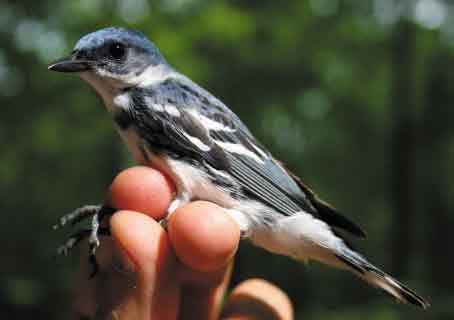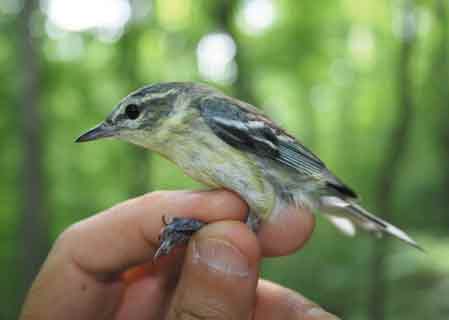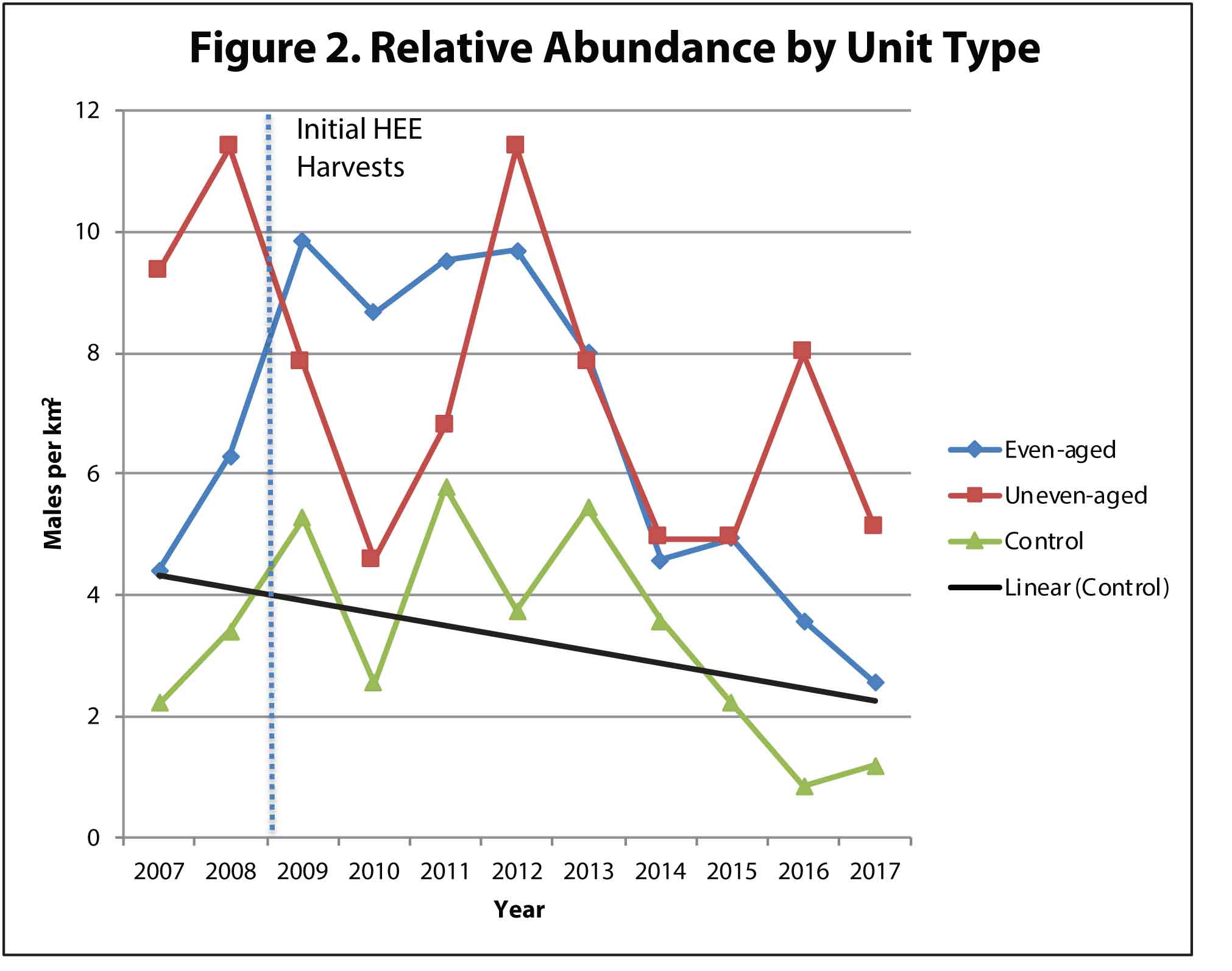Conserving the Rare Cerulean Warbler in Indiana Forests
The Cerulean Warbler is 4.5 inches in length and weighs less than 2 nickels (Figure 1). It migrates each year from its wintering grounds on the slopes of the Andes in northern South America to its breeding grounds that include forests in southern Indiana. The Cerulean Warbler faces many challenges and threats to its survival on its annual migration, which encompasses thousands of miles, from loss of habitat and severe weather events, to collision with tall, lighted buildings and windows.
 Figure 1. Male (left) and female (right) Cerulean Warbler.
Figure 1. Male (left) and female (right) Cerulean Warbler.
Once this songbird arrives in Indiana in mid- to late April, it establishes territories in structurally diverse mature forests characterized by large-sized trees interspersed with younger trees and with openings in the upper canopy. Research suggests that male Cerulean Warblers use these openings in the forest canopy to project their songs to attract females while defending territories against rival males. Historically, these openings resulted from wildfires and by wind storms and tree falls. However, the natural occurrences of many of these forest disturbances that allow canopies to open are prevented from the practice of fire suppression. More recently, openings were created from logging roads to extract timber along ridgetops.
Scientists that have conducted research on the breeding biology of Cerulean Warblers have documented a life history strategy that is self-limiting to its current survival. Unlike other songbirds that successfully produce 2 to 3 clutches per breeding season, the Cerulean Warbler is unusual in that it only produces one clutch of 3 or 4 eggs per breeding season unless the nest fails. We have observed females making up to three nesting attempts when earlier nests have failed. The female Cerulean Warbler gathers wild grapevine fibers and bark, and uses spider web to hold the nest materials together to construct a tiny cup-shaped nest. This nest is typically located 60 feet from the ground primarily in oaks and hickories. It is one of the earliest songbirds to leave southern Indiana departing by mid-to late July.
Cerulean Warbler research, conducted in various parts of its breeding range, has contributed to our basic understanding of Cerulean Warbler biology and habitat needs. However, there are some habitat differences between the various breeding grounds in North America. Informed decisions on forest management to maintain and improve Cerulean Warbler habitat should be location specific and based on scientific research conducted in the specific breeding ground. We were provided an opportunity to study the breeding biology and habitat needs of the Cerulean Warbler in Indiana through the Hardwood Ecosystem Experiment.
The Hardwood Ecosystem Experiment
The Hardwood Ecosystem Experiment (HEE), a 100-year study initiated in 2006, examines the effects of timber harvest and prescribed burns on plant and animal populations. The primary objective of this research is to develop even and un-even aged forestry systems that maintain oak dominated forest communities and landscapes. The HEE is a multi-disciplinary, collaborative project between the Indiana Department of Natural Resources, Division of Forestry, and scientists from a number of universities. Researchers study a variety of organisms that include moth, butterfly, beetle, and bird communities, small mammals, effects of prescribed burns on regeneration of oak seedlings, endangered Indiana bat, salamanders, eastern box turtles and timber rattlesnakes, and the state endangered Cerulean Warbler among other groups.
A total of 9 management units, 4 in Morgan-Monroe State Forest and 5 in Yellowwood State Forest in Morgan, Monroe, and Brown counties in southern Indiana were selected for the HEE. Three forest treatment sites received 8 small openings ranging in size from 1-5 acres where either single trees or groups of trees were removed; these areas will produce a future stand of trees of mixed or uneven-age. Another three treatment sites received two 10-acre clearcuts and two 10-acre shelterwood cuts to create a future stand of even-aged trees. And three sites will serve as controls where no harvest will occur for the duration of the 100-year study.
We started our research at the HEE in 2007 and obtained two years of pre-treatment data before the specific forest treatments were applied at the study sites in the fall and winter of 2008/2009. Our objectives examined 1) how Cerulean Warblers responded to different forest treatments across all management units, 2) if territory sizes changed depending on the treatment, 3) if canopy gaps were a preferred habitat characteristic of male Cerulean Warbler territories, 4) the effects of these different forest treatments on Cerulean Warbler reproduction and productivity, and 5) the species of trees that produced the most amount of caterpillars that were important prey items selected by the parents to feed to their young. Figure 2. Relative abundance estimates of Cerulean Warblers across nine HEE management units in Morgan-Monroe and Yellowwood state forests, Indiana, 2007-2017. While there is much variation in abundance from year to year, we observed a general decline. The cause is unclear, but given declines in the controls timber harvesting is not the cause.
Figure 2. Relative abundance estimates of Cerulean Warblers across nine HEE management units in Morgan-Monroe and Yellowwood state forests, Indiana, 2007-2017. While there is much variation in abundance from year to year, we observed a general decline. The cause is unclear, but given declines in the controls timber harvesting is not the cause.
Key Findings
Based on our HEE research, relative abundance estimates of Cerulean Warblers changed between pre-treatment and post-treatment years but territory sizes remained the same. Our data on relative abundance estimates suggests that Cerulean Warblers were attracted to forest sites with even-aged treatments initially based on an increase in detection rates during 4-years post-harvest but have since started to decline in these units (Figure 2). In contrast, they appeared to respond negatively to uneven-aged treatment sites based on decreases in detection during point count surveys two years after harvest; however, there is much fluctuation in numbers of Cerulean Warblers across years. There was little change in detections at control sites from 2007-2017. Preliminary data suggests that Cerulean Warblers are declining in our study sites (black line in Figure 2). This decline in population may be a reflection of the overall decline of the species across its range wide distribution, rather than from timber harvesting.
We examined 83 male Cerulean Warbler territories for canopy gaps and found that 38 territories did not have a canopy gap, which we defined as >greater than 215 square feetft2. The remaining 54% of territories had canopy gaps that ranged from 216- to 5,167 square feetft2 with a mean of 1,109 square feetft2, which is near the average size of a single tree-fall gap (753-1076ft2)created by a natural disturbance in mature forest systems. Therefore, emulating single tree fall canopy openings up to ~ 1076ft2/0.74acre(i.e. one large tree removed per average Cerulean Warbler territory size) would increase vegetative growth in the lower strata, and further increase the vertical vegetation density. However, it should be noted that this is not a long-term management approach to habitat conservation because oaks and hickories require sunlight to germinate and to out-compete more shade tolerant species. Based on our studies of Cerulean Warbler reproduction, oaks (particular white oak), and hickories are the most important tree species.
Nests were found in all forest management types and in all of the nine HEE units except for one of the control units. More nests were found in even-aged units than in uneven-aged or control units, despite intensive searching in all management types. Between 2011 and 2015, 93 Cerulean Warbler nests were found at our study sites. Of these, nearly half were located in species of the white oak group (Quercus alba, Q. montana [prinus], or Q. muhlenbergii), with white oaks (Q. alba) comprising the vast majority of nest trees (n = 37). Smaller numbers of Cerulean Warbler nests were found in a variety of other tree species. The preference for white oaks by Cerulean is likely due to an association with high food availability in the canopy and the presence of grapevines in areas where white oaks are also found. Of 101 territories demarcated in 2011 alone, grapevines were present in 83% of territories. At our sites, oak and hickory trees were found to contain a greater abundance of Lepidoptera (moths & butterflies) larva based on the amount of frass (caterpillar droppings) that was collected underneath the trees. Trees in the white oak group and hickories dropped nearly double the amount of frass compared to sugar maples. Based on follow-up studies of prey items delivered to nestlings and fledglings through intensive filming of prey delivery, lepidopteran larvae were the main food source for Cerulean Warbler nestlings.
Conclusions
Cerulean Warblers at our study sites showed a clear preference to nest in trees of the white oak group. In addition, lepidopteran larvae were more abundant on oaks and hickories in comparison with other tree species and were the principal food consumed by adults and fed to young. Historically, oaks and hickories were dominant species in the Indiana landscape prior to European settlement. Concurrent studies on the tree communities at our study sites indicate that the conversion of oak/hickory dominated stands to beech/maple dominated stands may be occurring as evidenced by the higher proportion of beech and maple saplings in the understory. This change may be detrimental to the nesting success of Cerulean Warblers in areas where this species historically relied upon oaks for nesting.
Cerulean Warblers may prefer characteristics (structurally complex forests with trees of multiple age) associated with uneven-aged timber harvests for their territories, but land managers and forest owners must balance this preference with the need to encourage regeneration of oak-hickory forests. Oaks are generally slow-growing, moderately shade-intolerant species, and the heavy reliance upon uneven-aged forest management frequently does not permit sufficient recruitment of oaks. Likewise, control areas (with no harvests or prescribed burns) may not undergo the level of disturbance needed for oak regeneration. Even-aged harvests such as small clearcuts and shelterwoods can potentially provide adequate habitat for mature forest breeders such as the Cerulean Warbler during the initial cuts while allowing oak regeneration for future nest trees and foraging habitat. Uneven-aged techniques that create larger openings, such as the patch cuts at the HEE, may also be valuable since over half of observed nests were found adjancet to canopy gaps. We found in our 2011 research that wild grapevine that was present in the majority of territories, is a forest component of great importance to Cerulean Warblers. The bark and fibers of grapevines are the main nesting materials that Cerulean Warblers use and substantiates the need to preserve wild grapevines in the forest.
Forest managers and woodland stewards are in a critical position to take actions that benefit these rare and beautiful birds so they can return and successfully breed in Indiana each year. A long-term forest management plan should take into consideration the habitat needs of the Cerulean Warbler that includes oak regeneration, maintenance of grapevines, mature forests, and canopy gaps on the landscape of its breeding grounds.
Kamal Islam is a Professor of Wildlife Biology at Ball State University. Since 2000, Dr. Islam and his lab has researched possible factors contributing to the rapid decline of Cerulean Warbler breeding populations in southern Indiana.
